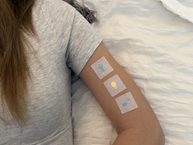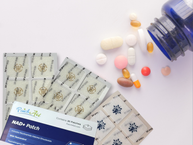Migraine sufferers know that a migraine is so much more than a mere headache. Marked by an intensity that can disrupt your day-to-day life, it’s crucial to develop effective strategies to not only treat migraines but also prevent them and alleviate the discomfort when they occur. Lifestyle adjustments and supportive tools such as PatchAid's Migraine Relief Patch* could possibly make a significant impact on your migraine experience.
Understanding Migraines: More Than A Headache
Migraines typically unfold in stages:
- Prodrome Phase: Up to two days before the migraine, signs like mood changes, neck stiffness, and fluid retention can occur.
- Aura Phase: This phase involves temporary disturbances such as vision issues and numbness, appearing before or during a migraine.
- Attack Phase: This is the acute stage, where intense headache, light and sound sensitivity, and nausea and vomiting prevail.
When you're in the throes of a migraine attack, relief is the priority. Post-migraine, it's time to think about future prevention. Here's a compendium of 13 tactics:
Migraine Management Tips
Immediate Relief:
- Seek Darkness and Quiet: Sensory overstimulation can exacerbate migraines. Find a dark, quiet space to let your senses rest. Sleeping shades or a simple towel over your eyes can aid in blocking light; earplugs can help mute disturbing sounds.
- Apply Heat: A heating pad or warm compress might help, increasing blood flow to relieve symptoms. Always follow your doctor's guidance to avoid burns.
- Opt for Cold Therapy: Change the game with temperature—using an ice pack or cold compress—especially if your migraine triggers include heat or sun exposure.
Preventative Measures:
- Stay Hydrated: Regular hydration can prevent migraines or reduce their severity. Aim for 8 to 10 cups of fluid daily, supplementing water with hydrating beverages like herbal teas or adding fruit for flavor.
- Identify and Avoid Triggers: Use a journal to pinpoint potential migraine triggers, such as stress, certain foods, or environmental factors, and take steps to steer clear of them.
During Warning Signs:
- Act Promptly: Recognize your body’s signals for an oncoming migraine and respond rapidly. This may involve hydrating, resting, or using a recommended medication or product like PatchAid’s Migraine Relief Patch* with your healthcare provider's consent.
Treatment Options:
- Medication: Over-the-counter medications serve as a standard response to pain, but it’s crucial to use them correctly under medical advice.
- Migraine Relief Patch: PatchAid’s Migraine Relief Patch includes vitamins and other ingredients believed to support energy, muscle relaxation, and overall immune function.*
Lifestyle Adjustments:
- Moderate Caffeine: While caffeine can ease migraine pain by causing blood vessels to constrict, balance is essential to avoid addiction or sleep disturbances.
- Optimize Sleep: Adequate sleep is a pillar of migraine prevention. Aim for 7 to 9 hours a night and improve sleep hygiene by reducing screen time before bed and following a consistent sleep schedule.
Remember, discussing with your healthcare provider before making any medication or supplement changes is essential.







